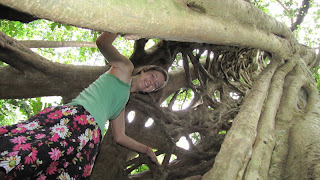Day 3 - The Monkey Sanctuary
This I remember, the red soil, the dust, the pools of dirt washing off at the end of the day. It’s an old memory from when my family lived in here 1968-69 and over Christmas break that year we took a “trek,” as we called it, to the north of Ghana. At the end of the day our faces were covered in red dust, and dust sweat lines across our clothes. In those days we traveled by Land Rover but today we travel by shared taxi. Last time I wrote about shared taxi, how they fill faster and hold four passengers but today we learned four is a purely theoretical limit, as they can hold more.
The Monkey Sanctuary, is located near the towns of Boabeng and Fiema, about an hour east of Techiman by taxi. Taxi negations are somewhat art and bluff, and there comes this point when you know if you’ve been taken, or made a good deal and today that point came about half way to the Monkey Sanctuary over some really bad roads. I realized we had not met another taxi or trotro for the past 30 minutes. It is a lonely place, and was nice to have a taxi waiting for us on the return journey. I also learned our taxi-driver, Edward’s wife lives in Boabeng so he was visiting her.
[Anna and Edmond, our guide]
[Colobus Monkey]
[baby Mona Monkey]
There are two species of monkeys. The smaller, more social Mona Monkeys, and the standoffish Colobus, with large white tails that follow behind them as they jump from tree to tree.
[Dan & Steve]
Later a virgin came to the village to whom the black and whites would speak to, and they would warn her when the village of danger, so the warriors could assemble to greet it. The virgin, named Afia, passed in 1978 and since that time there has been no one to protect or interpret. Edmond adds that if the black and whites make much ruckus between the hours of 1am and 2, and do so for seven days and then stop, that within that week one of the elders of the villages will die, and so they play the game “is it you?” He laughs, but I can tell he is very serious, “is it you…is it you?”
I don’t know that to make of such stories, I feel that Edmond believes them, and they have influence over his life. Which raises the question does a god have to exist to be real? Ghana is filled with stories of gods, gods of the water, the ocean, the fetish, and their priests. Even if not real, these beliefs exist, and have power, and influence over how people conduct their lives. Consider Tuesdays, when it is widely believed unsafe to swim, or fish in the ocean because that is the ocean god’s day.
The forest that surrounds these villages contain many interesting trees, including several of the parasitic Ficus trees. We’ve seen this before, [click here link to abouri] but last time I was too injured to climb inside climb the tree. It is a highly interesting experience to climb inside a tree.
[ficus tree picts]
Then we saw the monkey graveyard. It seems that when a monkey passes, it will come to the village to die at night, and the people will conduct a proper funeral, complete with wrapping in white cloth, and the fetish priest pouring libation.
In the grave yard there are two humans buried too, the virgin to whom the black and whites spoke to, and the former fetish priest. I get the feeling that the grave markers are for our benefit, as not even a people graveyard is as this well marked.
[Jollof Rice]
[Anna eating at Modern Way Canteen]
Back in Techiman we eat at Modern Way Canteen, and they are serving Jollof Rice, again. Jollof Rice is much like Spanish Rice served with a delicious hot paste called shito. It usually comes with a piece of fried chicken, and has been the dish of this adventure, meaning we’ve eaten it (only option on the menu) most days. Food options are three in most towns. Street food, for which there is plenty. Right now roasted corn is in season. Its good, but it isn’t sweet corn, or at least as we know it in the States, but chewy field corn. Other options are kabobs, and some soup dishes I'm not brave enough to try. Next up are the canteens, or drinking spots. These have covered open air seating areas¸ and are away from the street. Modern Way has a TV and we watch the World Cup playing while we eat. Next up are the hotels and stand alone restaurants which will have AirCon, extensive menus, and can be quite pricy. Usually they are empty, and when we come in, even the long established ones, its like we’re the first customer they have ever had. Maybe its because we’re not Ghanaian and there is a different expectation, but they scramble to find a menu, turn on the AirCon and awkwardly take our orders. So we much prefer the Canteens though the Jollof Rice is getting to be a little bit too much.
Get the whole story on our Blog http://www.buchele.blogspot.com/















0 Comments:
Post a Comment
<< Home